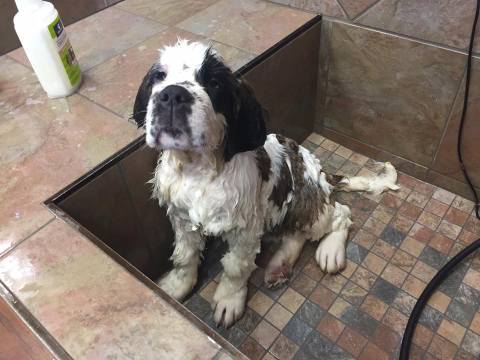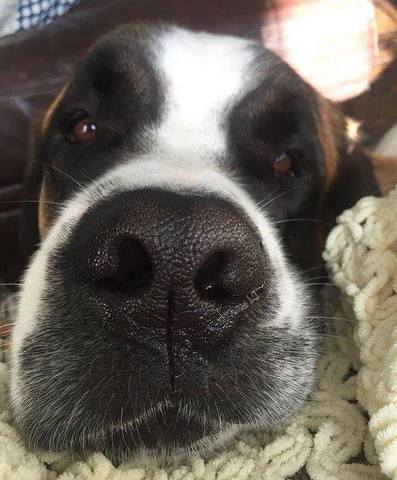GROOMING
I once read “if you can wash a car, you can bath a St Bernard”.
In principal this is correct, in practice…well.
Like all training, the earlier you start bathing & grooming your dog and clipping their nails, the more readily they will accept it as part of their routine.
Brushing your puppy should be a daily event from the first day home and is not only a chance to clean your dog, but also a chance to bond, and an opportunity to check them for lumps, parasites, sores, skin conditions etc.
Brushing your dogs coat regularly removes dirt and debris from the skin and the coat, removes loose hair, stimulates the blood supply for healthier skin and a shinier healthier coat and prevents knots forming (and the consequential pyoderma that can develop under them).
It is relaxing for your dog and reduces the ‘doggy’ smell and the frequent need for a bath, and reduces the amount of dog hair in your environment.
This exercise will only take a few minutes each day with the exception of moulting time. St Bernards moult usually twice per year, in Autumn and again in Spring. This is when they loose their undercoat although being a double coated breed they tend to shed a little all year round.
Indoor dogs may blow their coat annually and shed more evenly throughout the year because their body temperature is more controlled.
The basic brushes required for a St Bernard are a slicker brush for the ears and general coat, and a pin brush for the tail and longer feathering on the back of the legs. Some people prefer to comb their dog through after brushing.
At the time of brushing your Saint, check their ears for excessive wax or smells, check your dogs eyes for discharge, check their feet and between their toes for grass seeds and pads for cuts.
Also check to make sure their nails do not require a trim.
If your Saint has a strong doggy odour and it is not possible to bath them, a dry shampoo (from a pet shop), can be used following the instructions, until bathing is possible.
If the front legs of your Saint get dirty from food or slobber, a hot towel (wet a towel with hot water and wring out while still hot) rubbed vigorously over the legs will clean them up.
You will be surprised at how mud falls out of their coat once it has dried.
If bath time is inevitable, choose early morning on a warm day to allow your dog to dry properly before bed time.
Use a good dog (not human) shampoo and start by wetting your Saint all over except for their head. 
(They will be less inclined to shake water all over you if you leave the head until last)
Apply shampoo sparingly and lather in well, rinse off and apply conditioner. Now gently wet the head and shampoo keeping water out of their ears and eyes. Rinse the whole dog in warm water running your fingers through the coat to check for area not rinsed out.
Some people bath their dog inside in their own bath. That is brave.
Dog wash booths have now sprung up in most towns and using their washing facilities and drier is a better option to having to clean your house after a wet dog has run through it.
Dry shampoo powder is available and useful for when you cannot give your dog a wet bath or 'in between' baths.
A towel rinsed in hot water and rung out, then rubbed through the coat, also helps keep the coat clean.
Wash your dogs bedding at the same time as you bath your dog.
Eyes should be bright and clear with no discharge or wetness around the eye. 
Nose should be wet and shiny and free from cracks and sores. If the nose is dry, use your finger to apply a little Vaseline, Coconut Oil or Blistex Lip Balm and rub in well. If your dog is inclined to lick it off, after applying the gel, feed them a biscuit to give them something else to focus on.
Ears should be discharge free and the ear flap cleaned. Do not be tempted to put chemicals or liquid or objects such as tissues, cotton buds etc down the ears to achieve a squeaky clean ear canal. The flora of the ear canal is finely balanced and a little wax is not a bad thing.
Nails should be cut using either guillotine (only good for puppys) or plier style cutters being very careful not to cut the ‘quick’. (Google How to Cut my Dogs Nails). You may need to use an emery board or dremel tool to tidy the ragged nail end.Your dogs nails are too long when you can hear them ‘clicking’ on the floor or concrete. Overly long nails will negatively impact on how your dog walks.
Teeth should be clean and pay attention to them. A large build up of tartar on the teeth can be dangerous and you should consult your vet. Smaller breeds can gnaw on bones to clean their teeth but this is NOT recommended for a St Bernard. Instead give them hard biscuits, raw chicken necks and carrot pieces to help to keep their teeth clean.